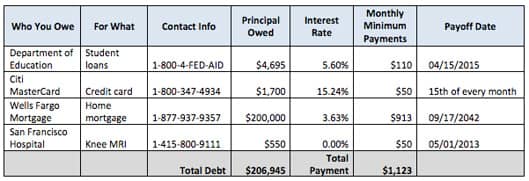

Choosing to get serious about paying down your debt is a big step. It’s a commitment you’re making to yourself to take back control of your finances.
However, just as acquiring all that debt didn’t happen overnight, paying it off won’t be a quick or easy task either. But if you are committed, you can make it happen.
Believe it or not, the biggest obstacle to debt repayment isn’t a lack of effort or of good intentions – it’s the lack of a comprehensive plan. So if you’ve finally had enough and are ready to eliminate the debt that’s been burdening your life, you’ve taken a great first step.
This seven-step debt repayment plan will help you to focus your efforts and channel your resources into ridding yourself of debt and living a more financially enjoyable life.
So let’s get started…
1. Organize your debt into categories
The first step in any debt repayment plan is to understand exactly where you are with respect to your financial obligations. Often people become so overwhelmed with their debt burden that they lose track of just how much they owe and to which creditors.

This debt repayment table from nerdwallet.com is a good template for how you could organize your debts.
By organizing your debt into a single list or spreadsheet, you can easily see where you stand, even if it seems terrifying. Be sure to list the amounts owed and the interest rate that you are charged on each debt.
If you think your debts are too out of control to handle yourself, considering contacting a debt relief or bankruptcy firm to help you get your finances in order.
2. Prioritize repayment
Next, you’ll need to prioritize which of your outstanding debts to focus on first. While this may seem mundane, it’s actually one of the most important parts of creating a debt repayment plan.
Essentially there are two ways to focus your financial efforts: by paying off high-interest debt first or by focusing on eliminating your smallest balances first (also known as the “snowball method”).
If you have a large number of small debts, it may make sense to get them out of the way before tackling the big debts. However, paying down the high interest cards and loans first will save you more in interest charges.
3. Develop a strategy
Once you’ve listed and prioritized your debt, you can choose which payoff strategy makes the most sense for your situation. You can also decide which method will keep you motivated to continue: crossing off the smaller debts from your list or paying down high-interest debts.
In either case, you’ll need to maximize the amount you’re putting toward your debt each month and focus all of your financial efforts toward paying it off.
Once you’ve eliminated one, redirect that money toward the next bill on the list. This may mean making minimum payments on some debt until you’ve paid off the higher priority ones first.
4. Be consistent
When it comes to your debt repayment plan, consistency is key. Be relentless in your focus on paying down the debt. Just because you’ve paid off one debt is no reason to relax or to celebrate. Divert that money right into the next debt without missing a beat.
“Just because you’ve paid off one debt is no reason to relax or to celebrate.”
5. Use an app
Believe it or not, there are mobile apps that can really help you in managing and tracking your debt repayment plan. Many can also help you to identify which debts to pay off first, and how to maximize your efforts.
Using a mobile app also has the effect of tracking your progress and seeing the incremental improvements you’re making. Plus they’re just convenient to use.
6. Build your savings
A big part of staying out of debt is to make sure you have enough savings that you don’t have to put emergency expenses on a credit card.
Having savings will also allow you to pay off any credit card bills before they accrue charges, giving you an interest-free loan while you take advantage of the credit card rewards and perks.
7. Plan to stay out of debt
The final step in your debt repayment plan should include a plan to stay out of debt. This means making a commitment to change your spending patterns and your financial habits. The last thing you want is to wind up back in the hole after you’ve made all this progress.
Just as racking up a pile of debt doesn’t happen overnight, debt repayment isn’t going to come quickly either. But with dedication, desire, and a step-by-step debt repayment plan, you can rid yourself of debt and stay that way. Good luck!
Advertiser Disclosure
BadCredit.org is a free online resource that offers valuable content and comparison services to users. To keep this resource 100% free for users, we receive advertising compensation from the financial products listed on this page. Along with key review factors, this compensation may impact how and where products appear on the page (including, for example, the order in which they appear). BadCredit.org does not include listings for all financial products.
Our Editorial Review Policy
Our site is committed to publishing independent, accurate content guided by strict editorial guidelines. Before articles and reviews are published on our site, they undergo a thorough review process performed by a team of independent editors and subject-matter experts to ensure the content’s accuracy, timeliness, and impartiality. Our editorial team is separate and independent of our site’s advertisers, and the opinions they express on our site are their own. To read more about our team members and their editorial backgrounds, please visit our site’s About page.




